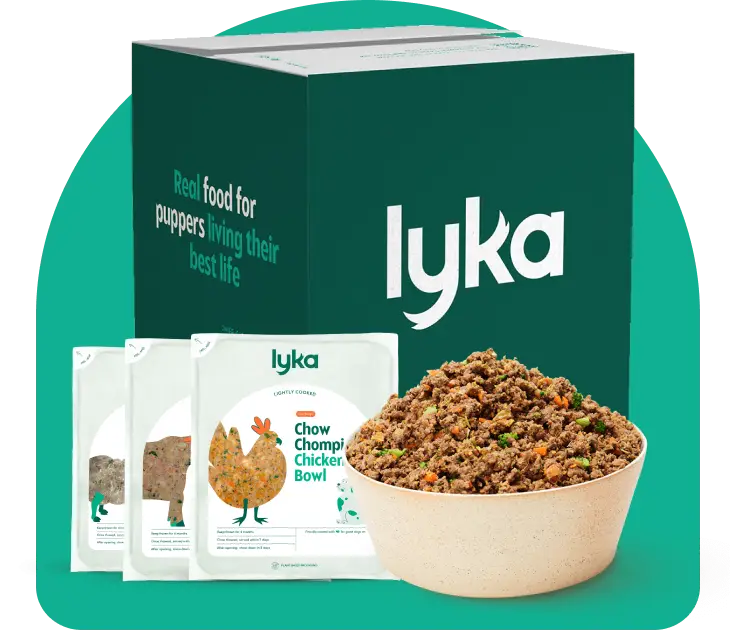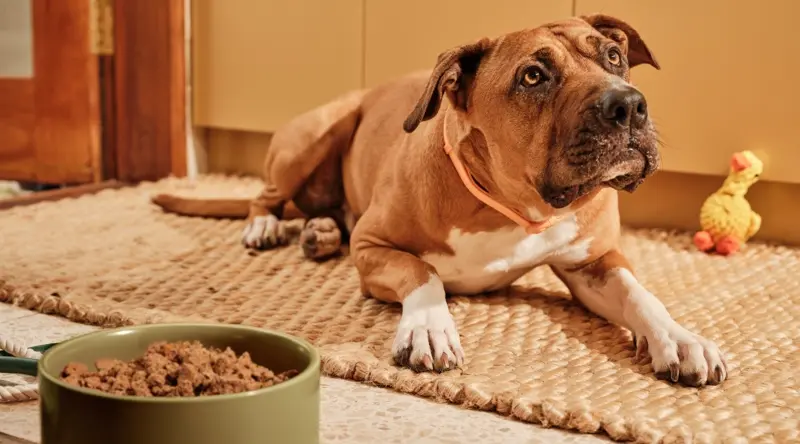Dealing with tear stains on your dog? You’re not alone. These pesky stains often stem from overlooked factors like sub-optimal diets or hidden health issues. The good news? With the right approach, they’re not just manageable — they’re often preventable.
The causes and solutions to tear stains are clearer than they seem. With evidence-based tips and smarter food choices, you can take actionable steps to help your dog live their healthiest, happiest life. Let’s get started on eliminating tear stains for good.
What are tear stains?
Tear stains are caused by an overproduction of tears from the tear gland above your dog’s eye. The veterinary term for this is epiphora.
Your dog’s tears contain a pigment called porphyrin: an iron-containing molecule produced by the body when it breaks down red blood cells.
Porphyrins are excreted through the gastrointestinal tract, urine, saliva, and tears – this pigment causes the rust-coloured staining.
Although the rust-coloured stain is more noticeable in white dogs, it’s a common problem for all breeds. If your dog shows signs of staining, make an appointment with your veterinarian to investigate further.
Can my dog’s diet cause tear stains?
Yes, your dog’s diet may contribute to their tear stains — with certain ingredients playing a key role in this stubborn problem.
Your dog needs dietary iron to help the blood carry oxygen around their body via their circulatory system.
High-quality protein, like Lyka's grass-fed beef, lamb, and free-range chicken, contains natural sources of iron that can be readily absorbed by the body, compared to synthetic sources.
Unfortunately, many dry food companies use low-quality meat by-products which can affect the iron content, meaning synthetic iron often needs to be added.
When the body breaks down iron, porphyrin is released. Excess iron in your dog’s diet can directly increase the amount of porphyrin in your pup’s tears causing staining.
🐶 Read more: Freshly cooked vs kibble for dogs: which is better? →
Allergies
Dog skin allergies and intolerances can trigger an immune response like watery eyes, a leading cause of staining in dogs.
Inflammation from allergic reactions can also block the tear ducts (nasolacrimal ducts). These are small holes in your dog’s lower eyelid that drain excess tears into the sinus and down their throat. When these are blocked, there’s nowhere for the tears to go except down their face.
High glycaemic index (GI) carbohydrates
High-GI ingredients like wheat, corn and other cereals can trigger grain flare-ups, an allergic response causing inflammation that constricts the tear ducts and sinuses.
If your dog produces excess tears, or their tear ducts are blocked, it can make their skin and fur permanently damp – an ideal place for yeast, bacteria, and fungus to grow. Yeast infections under the eyes create brownish staining.
)
9 tips and tricks to prevent tear stains in dogs
The best way to stop tear stains is to address the underlying cause first. Otherwise, the problem is likely to persist.
#1: Avoid grain flare-ups
Grain-free dry food may not contain wheat, soy or corn, but they aren’t necessarily the healthier option. Many brands have replaced grain ingredients with a high proportion of legumes that have been linked to canine-dilated cardiomyopathy (DCM).
Lyka meals are legume-free, and we only use the nutritious ancient grain, quinoa, in our Lamb and Turkey meals. This means you don’t have to worry about your dog experiencing watery eyes and staining — triggered by a grain flare-up.
#2: Improve their immune response to allergens
Your dog's immune system is mostly regulated by their gut microbiome. An over-reactive immune system can lead to excessive tear production.
Nourish your dog's gut and support an effective immune system with a real food diet full of bioavailable ingredients and dietary fibre.
#3: Diets containing Vitamin C
Vitamin C supports your dog’s body’s absorption of iron. Meals containing fresh fruit and vegetables provide bioavailable sources of Vitamin C — rather than synthetic forms.
#4: Reduce stress and anxiety
Minimise stress-induced inflammation and tear stains by supporting your dog’s calm behaviour. Remove the triggers that cause anxiety or develop an action plan for anticipated stressors, like fireworks and storms.
Consider dietary supplementation to improve their feelings of wellbeing, like Lyka Calm Supplements, containing active ingredients like passionflower extract to calm the mind.
#5: Veterinary treatment
If tear stains are linked to a yeast, bacterial or fungal infection your vet may be able to provide some medication to deal with the primary problem. Once that has cleared up, you may notice a change in their staining.
If your dog’s excess tears stem from entropion or a blocked tear duct, your vet can investigate further and advise you on the next steps.
Glaucoma or other eye problems can be treated by your vet, or you may be referred to a veterinary ophthalmologist who specialises in animal eye care.
#6: Metal food and water bowls
Plastic bowls can harbour bacteria in scratches or cracks leading to infections. Switch to metal bowls to minimise the risk of pathogens.
#7: A clean and dry face
Use a clean, damp cloth to remove dirt or environmental allergens like dust or pollen from your dog’s face and towel dry gently afterwards.
Check their ears and nose health to make sure they’re free from irritants or infection that may block the sinus passageways, preventing the drainage of tears.
#8: Hydration
Keep your dog hydrated to help their liver process dietary iron. Use filtered or distilled water to avoid the excess minerals that are added to tap water.
#9: Homemade tear stain removers
You can use a small amount of coconut oil to gently rub away some of the staining.
A mix of equal parts water and apple cider vinegar is another homemade solution.
Another preventative remedy is to add a few drops of lemon juice or apple cider vinegar to your dog’s water to increase the acidity, which can reduce staining.
With any remedy, avoid any contact with their eyes. Not all dogs like the sensation of having their face touched, so proceed with caution and give plenty of praise and rewards.
)
What are other causes of tear stains?
Blocked tear duct (nasolacrimal) duct
Inflammation, infection, and grit can block the tear ducts or the sinuses, making them unable to drain excess tears.
Eye infections
Conjunctivitis and other eye infections can increase tear production as the body tries to alleviate the irritation.
Inverted eyelids (entropion)
Entropion is usually a hereditary or developmental problem where the lower eyelid turns in on itself: causing a dog’s fur and eyelashes to rub against the eye. It’s an uncomfortable disorder that makes a dog’s eyes water and produces thick discharge and can lead to painful ulcers on the cornea.
Ingrown eyelashes
Ingrown eyelashes or extra eyelashes that grow in the wrong location (distichiasis) can irritate the eye's surface, triggering an increase in tears and thicker discharge to lubricate the irritated area.
Glaucoma
Glaucoma generates a build-up of fluid in the eye creating pressure leading to an overproduction of tears.
Ear infections
Like humans, a dog’s ears, eyes, nose and throat are connected by a network of ducts, cavities and tubes. Ear infections can also affect the eyes causing blocked ducts, epiphora and tear stains.
Irregular grooming
Long hair can irritate a dog’s eyes causing tears, it can also harbour yeast or bacteria if the area stays warm and damp. Regular grooming to keep the hair around their eyes short can improve the issue.
Stress and anxiety
Stress hormones trigger an immune response that can create inflammation in the body. Inflammation can block the tear duct, causing tear stains.
Puppy teething
When a puppy is teething, they’re often feverish with swollen gums. This can increase tear production and staining.
Breed disposition
Some breeds are more predisposed to tear stains than others because of their body shape. Breeds like Boston Terriers, Chihuahuas, and Pugs have protruding eyes that can be injured, infected, or irritated easily.
Brachycephalic dogs, like Brussels Griffons, Bulldogs, and Pekingese have shortened nasal passages that can become blocked, making it harder to drain tears away.
Imperforate punctum is a condition where the tear duct opening hasn’t developed properly, preventing the normal drainage of tears. It’s more common in breeds like Labrador Retrievers, Golden Retrievers and Cocker Spaniels.
)
Lyka: the holistic way to reduce tear stains
Tear staining might seem like just an aesthetic concern, but it’s a sign of what’s happening beneath the surface. With Lyka, you’re not just improving how your dog looks — you’re helping them thrive from the inside out.
Our meals, thoughtfully crafted by board-certified veterinary nutritionists, are packed with real ingredients designed to enhance gut health and strengthen immunity, tackling tear stains at their root.
Your dog deserves more than just food — they deserve real nourishment. Discover the Lyka difference today.
--
This article was reviewed by Cindy Feng, Lyka R&D Director.
)
)
)
)

)
)
)
)
